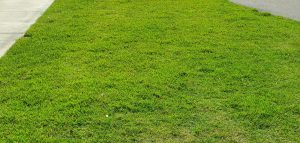
Two universal truths about lawns – there is no perfect grass, they all have their advantages and disadvantages, and lawns go from order to disorder over a period of time unless you step in and make corrections while they are small. St. Augustine grass and Bahia grass are popular lawn subjects, but many people are looking at Zoysia grass. This relatively new grass to the neighborhood offers a different texture and improved overall performance compared to past Zoysia cultivars thanks to breeding efforts. Is Zoysia grass for you?
Let’s look at the advantages and disadvantages of using Zoysia as turf grass. Zoysia can be maintained on less nitrogen than St. Augustine grass, has a very dense growth habit, and can be mowed fairly low – two to two and one-half inches in the case of ‘Empire’ Zoysia, a common cultivar. On the flip side, it takes as much water as St. Augustine (and will go dormant and turn brown without water), can develop thatch if overfertilized with nitrogen, is susceptible to hunting billbug (an insect pest) and can develop a fungal disease called large patch. For the most part, these disadvantages can be managed. Zoysia is normally established with either vegetative plugs or sod. There is no need to apply fertilizer until thirty to sixty days after establishment. Immediately after any fertilizer application, water it in with one-quarter inch of irrigation. Don’t forget to review our Charlotte County Fertilizer Ordinance – please see here – https://sfyl.ifas.ufl.edu/media/sfylifasufledu/charlotte/docs/pdf/Fertilizer-Ordinance1.pdf – for more details on proper fertilization and the Restricted Season.
Mow Zoysia when the grass blades are three to four inches high so that you only remove about one-third of the grass blade. Water turf so that you apply one-half to three-quarters of an inch of irrigation per event. Check local utilities for any watering restrictions and application times.
As mentioned above, hunting billbugs, a tiny weevil, are perhaps the most common Zoysia grass insect pest. Most of the damage occurs from fall to spring with symptoms including damaged stems and rhizomes causing patches of turf to die in an irregular pattern. Large patch is a fungal disease that is also most common during the cooler part of the year. Large patch causes yellow patches to develop which turn brown and can expand to several feet in diameter. While there are fungicides to control this disease, cultural practices such as not using excessive nitrogen during seasons most conducive to this disease and limiting irrigation to early morning so that the grass can dry out. Mow diseased areas last and wash grass clippings off before mowing disease-free areas.
‘Empire’ Zoysia is the most popular Zoysia in our area and the cultivar most likely to be found at garden centers and sod farms. Good color and successful performance on sandy soils and competitive growth make ‘Empire’ an appropriate choice. ‘Icon™’ is another zoysiagrass cultivar developed in Australia known for its very high salt tolerance, and little thatch production. Zoysia offers a different texture that our other common warm-season grasses do not provide. That other turfgrass, Zoysia is becoming more popular all the time! For more information on all types of turf questions, or to ask a question, you can also call the Master Gardener Volunteer Helpdesk on Mondays, Wednesdays, and Fridays from 1 to 4 pm at 764-4340 for gardening help and insight into their role as an Extension volunteer. Ralph E. Mitchell is the Director/Horticulture Agent for UF/IFAS Extension Charlotte County. He can be reached at 941-764-4344 or ralph.mitchell@charlottecountyfl.gov. Connect with us on social media. Like us on Facebook @CharlotteCountyExtension and follow us on Instagram @ifascharco.
Resources:
Unruh, J. B., Schiavon, M., Lindsey, A. J., Kenworthy, K. E. & Trenholm, L. E. (2022) Zoysiagrass for Florida Lawns. The University of Florida Extension Service, IFAS,
Elliott, M. L. & Harmon, P. F. (2018) Large Patch the University of Florida Extension Service, IFAS.
 0
0
